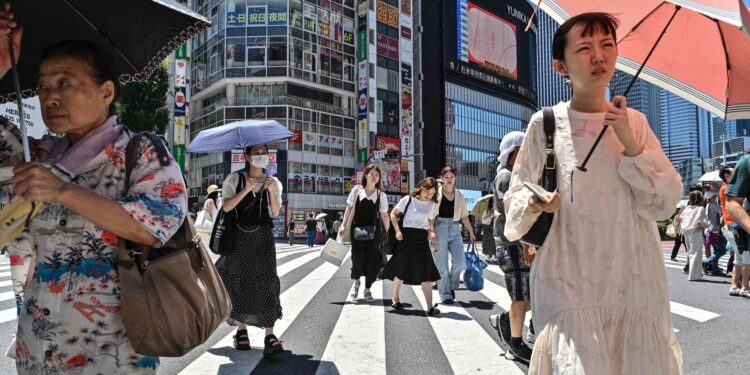Japan’s Economy Shrinks as Trump’s Trade War Hits Exports and Shakes Confidence
In a significant development for the global economy, Japan has reported a contraction in its economic output, a troubling sign that the ongoing trade tensions initiated by former President Donald Trump’s tariffs are reverberating beyond U.S. borders. Official data released this week reveal a decrease in exports — a crucial driver of Japan’s growth — as manufacturers and exporters grapple with increased costs and uncertainty. This downturn not only reflects the direct impact of the U.S.-China trade war on Japanese trade but also signals a broader loss of confidence among businesses and consumers. As the world’s third-largest economy navigates these challenges, analysts are closely watching the implications for both domestic policy and international markets.
Japans Economic Contraction Analyzed Amidst Global Trade Tensions
Japan has experienced a notable shrinkage in its economy, driven primarily by escalating trade tensions triggered by former President Trump’s policies. Exports, a crucial component of the Japanese economic landscape, have been significantly impacted by tariffs and trade barriers, which have disrupted established supply chains and reduced market access for Japanese goods. This contraction was not merely an economic statistic; it reverberated through business sentiment, causing companies to reconsider investments and workforce strategies in the face of uncertainty.
Key factors contributing to the downturn include:
- Decreased Export Revenues: Higher tariffs have diminished demand for Japanese products abroad, notably in the technology and automotive sectors.
- Supply Chain Disruptions: Global supply chains have faced interruptions, leading to production delays and increased operational costs.
- Consumer Confidence Decline: The trade war has eroded public confidence, with consumers tightening their spending amidst fears of economic instability.
To provide a clearer picture of the economic impact, the following table summarizes key indicators from the recent quarter:
| Economic Indicator | Previous Quarter | Current Quarter | Change (%) |
|---|---|---|---|
| GDP Growth Rate | +1.0% | -0.5% | -1.5% |
| Export Volume | 600 billion JPY | 550 billion JPY | -8.33% |
| Consumer Spending | +0.7% | -0.2% | -0.9% |
Impact of Trade War on Japanese Exports and Domestic Confidence
The ongoing trade war, ignited by the United States’ tariffs on a variety of goods, has delivered a significant blow to Japanese exports. Key industries, including automotive and electronics, have reported notable declines in demand from overseas markets, primarily due to the escalating costs imposed by tariffs. As a result, manufacturers are grappling with shrinking profit margins and have been compelled to reassess their supply chains. The repercussions are sweeping, as evidenced by:
- A 10% drop in automotive exports to the U.S. in the first half of the fiscal year.
- Electronics producers reporting a 15% decrease in shipments abroad.
- Increased reliance on domestic markets leading to a surge in competition among local businesses.
Moreover, the uncertainty surrounding trade policies has significantly shaken domestic confidence. Consumer sentiment has dipped, reflecting concerns about future economic stability and job security. This anxiety is palpable across various sectors, with many businesses hesitant to invest in expansion or new ventures. A recent survey illustrates this shift:
| Indicator | Current Status | Change from Last Quarter |
|---|---|---|
| Consumer Confidence Index | 75 | -5 |
| Business Investment Growth | -2% | -1% |
| Export Growth Rate | -3% | -2% |
This combination of falling exports and declining consumer and business confidence underscores the challenging landscape Japan faces as it navigates the complexities of international trade in a time of heightened tension.
Strategies for Recovery: Strengthening Japan’s Economy in a Shifting Landscape
The economic landscape in Japan faces significant challenges amidst the ongoing effects of global trade tensions and domestic uncertainties. As exports decline and confidence wavers, policymakers are urged to adopt several strategic measures aimed at revitalizing growth. Key strategies include:
- Increased Investment in Innovation: Encouraging tech advancement through government grants and partnerships with private sectors to boost productivity.
- Enhancing Trade Relationships: Proactively expanding free trade agreements to create new markets for Japanese products and reduce dependency on traditional partners.
- Support for Small and Medium Enterprises (SMEs): Implementing financial incentives and resources to empower SMEs which are vital to local economies.
- Strengthening Domestic Consumption: Implementing policies such as tax cuts or subsidies to incentivize spending amongst consumers.
Additionally, a thorough analysis of the effects of foreign policy on local markets is paramount for effective recovery strategies. Data-driven assessments must guide future decisions, including:
| Key Indicators | Current Status | Projected Impact |
|---|---|---|
| Export Growth Rate | -2.5% | Continued declines may pressure GDP |
| Consumer Confidence Index | 45 (Low) | Increased spending likely with recovery plans |
| Investment in R&D | $120 billion | Potential for long-term growth and innovation |
By focusing on these areas, Japan can navigate the rough waters caused by external pressures and ensure a more resilient economy moving forward.
Closing Remarks
the latest economic data from Japan reveals a contraction that underscores the significant impact of global trade tensions, particularly stemming from the ongoing trade war initiated during the Trump administration. As exports falter and business confidence wanes, policymakers face a challenging landscape as they work to stabilize the economy and foster growth. The situation highlights the intricate interdependencies of international trade and the urgent need for adaptive strategies in an increasingly volatile global market. With key economic indicators signaling potential hurdles ahead, all eyes will be on Japan’s response as it navigates these turbulent waters in the months to come.































